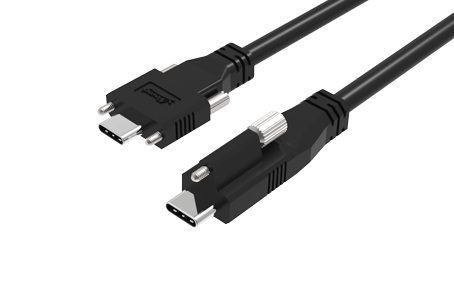What is USB Type-C?
USB Type-C, also known as USB-C, is the latest USB connector developed by the USB Implementers Forum (USB-IF). It was designed to gradually replace all previous USB connector types, including USB Type A, Type B, Mini and Micro USB. Since 2015, USB Type-C has been widely adapted in a great number of laptops, mobile phones, and storage devices in the consumer electrics market. It allows those devices to transfer data faster while staying in a much smaller form factor.
Recently, the acceptance of Type C for industrial applications, such as machine vision cameras, medical imaging sensors, 3D capturing devices, etc., has been accelerated.
Why USB Type-C is better?

Type-C Connector Plug
Compactness of the USB Type-C connector size is much smaller than the previous USB connector types, such as the USB standard A. With aid of Type C, manufacturers’ dream for shrinking their devices to an unprecedented level came true. Reversibility Its unique and friendly symmetric connector design made USB Type C work regardless upward or downward facing orientation when you plug it to the USB-C port.
Type-C Locking Connector
In the past years, some industry groups came up with their own USB connectors with locking mechanisms. For example, machine vision industry group had developed USB3 Vision locking connector standard in order to secure the USB interconnections for machine vision applications.

Type C with Dual Screw Locking and Type C with Single Screw Locking
However some of these locking connectors are not compatible with each other. Sometimes two locking connectors with similar appearance are not interchangeable due to screw center spacing or thread size, which creates a lot of confusion and misuse among users.
In response to the growing needs for secure interconnections across industries, USB-IF standardizes USB-C locking connectors for the first time in USB history. USB Type-C Locking Connector Specification introduces two types of industrial standard locking mechanisms for the USB Type-C connector to meet needs of different applications.
Dual Screw Locking Connector The dual screw USB Type-C plug connector is defined for applications that may have restricted height or that may require the additional securing capability provided by a second locking screw. The dual screw version can be locked in either plug orientation.
Single Screw Locking Connector The single screw USB Type-C plug connector is defined for applications that may have restricted width for the locking screws.
Several companies have adopted the standard Type C locking connector on their latest USB-C industrial cameras, such as Intel, Google, Asus and TechNexion cameras. It’s believed that USB3 Vision standard committee will incorporate the USB Type-C locking standard to their newly updated version of USB3 Vision specification very soon.
Future of USB Type-C in Machine Vision
With all the advantages brought by USB-C and the emerging USB 3.2 standard, USB Type-C connector will probably turn into the only remaining USB port, though it will still take a few more years for the Type-C to be as popular as the Type-A on the host side. For industrial applications, we will definitely see more and more peripherals such as machine vision cameras to be featured with Type-C port.
Type-C Cable Length Limit
USB Type-C enables a great deal of advanced features for USB connections. However users and integrators are also facing new challenges. For instance, machine vision users concern about how to break the length barrier of the Type-C cables. According to Type-C specification, the compliant USB 3.1 Gen 2 C to C full feature cable right now is limited to one meter. Whereas, many current USB 3.0 users are very often using 3m, 5m or even longer cables for their applications.
| USB 3.1 Cable Length | ||
| USB-C to USB-C | USB 3.1 Gen 2 | up to 1 m |
| USB-C to USB-C | USB 3.1 Gen 1 | up to 2 m |
| USB-C to USB-A | USB 3.1 Gen 2 | up to 1 m |
The short length of Type-C cables does impose limitation to the adoption of Type C for industrial applications such as machine vision and professional audio and video applications that require long range connections. Currently, to overcome the length barrio of Type C applications, companies are putting tremendous efforts for developing long range active repeaters or extension cables with Type C features. However TechNexion solved this barrier with Vizionlink™ camera's that can extend the cable length to a stunning 15 meter.
